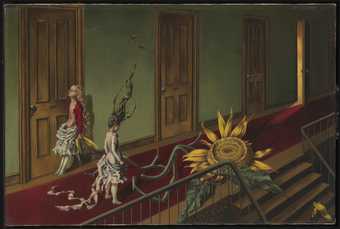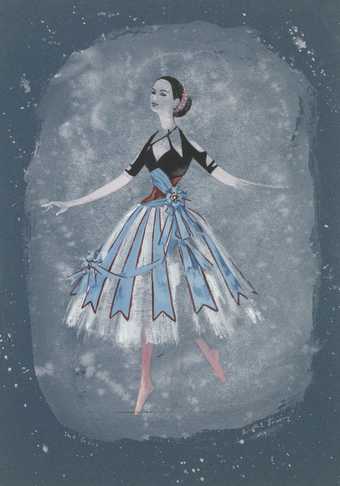Introduction

Dorothea Tanning
Eine Kleine Nachtmusik
(1943)
Tate
This exhibition surveys the seventy-year career of Dorothea Tanning (1910–2012), whose work always asks us to look beyond the obvious. As a young artist in 1930s New York she discovered surrealism and what she described as the ‘limitless expanse of POSSIBILITY’ it offered. The movement, which had emerged in Paris in the 1920s, explored the hidden workings of the mind as a source of art and writing. Working in the United States and France, Tanning took its ideas and imagery in new, distinctive directions. This exhibition focuses on key themes and developments in Tanning’s practice across her long and extraordinary career.
I wanted to lead the eye into spaces that hid, revealed, transformed all at once and where there could be some never-before-seen-image.
Dorothea Tanning
Room 1: Birthday
Every one of my paintings is a step on the same road. I see no break or detour, even temporary. The same preoccupations have obsessed me since
the beginning …Dorothea Tanning
Tanning was born in the small town of Galesburg, Illinois, where, she said, ‘nothing happened but the wallpaper’. She escaped to other worlds through Gothic novels and poetry. In the 1930s she travelled to Chicago and then New York to pursue a career as an artist. Her first encounter with surrealism was the exhibition Fantastic Art, Dada, Surrealism at the Museum of Modern Art, New York in 1936. She identified in the movement an ‘effort to plumb our deepest subconscious to find out about ourselves’ and embraced this approach in her own art.
In 1939 she sailed to Paris, hoping to meet surrealists there. The outbreak of the Second World War forced her to return to New York, where she supported herself by working as a freelance commercial artist. The war brought many European surrealist writers and artists to the city. The German painter Max Ernst was among these cultural refugees. He was introduced to Tanning in 1942 and they married in 1946. This room shows Tanning’s early engagement with surrealist imagery and symbolism. Her self-portrait Birthday 1942 marks her ‘birth’ as a surrealist. The game of chess represents intellectual and artistic interplay with members of the surrealist circle, as well as her romantic link with Ernst.
Room 2: Behind the door
I think I could live anywhere if allowed to create freely … My personal space is so richly furnished that there is absolutely no room in it for any feeling of exile … Also, behind the invisible door (doors), another door.
Dorothea Tanning
Works from across Tanning’s career show doors left ajar or leading to other doors. The door becomes a surrealist symbol, a portal to the unconscious. While the open door represents choice and possibility, doors may also be used to lock up our most secret fears and desires. In the mid1940s, Tanning and Ernst moved to Sedona, Arizona, where they built a house and spent much of the next decade. Tanning responded to the overwhelming heat and drama of the desert landscape by creating an alternative reality of indoor spaces. She explained:
the decibels of nature can crush an artist’s brain… So I lock the door and paint interiors… A white and dark picture would muffle the red world outside.
Tanning found creative freedom in the desert, but her works from this period depict unsettling, claustrophobic scenes. A young figure on the threshold between childhood and adulthood appears in several paintings. Tanning often pictured her near a doorway as an active figure who disrupts the familiar and domestic.
In 1984 Tanning incorporated a real door into her painting Door 84, dividing the composition in two. The loosely painted figures on either side appear to be pushing against the door to hold it in position at right-angles to the canvas.
Room 3: The Family Table
[On growing up in Galesburg, Illinois]: There was a long dining room table that on Sunday, especially when the pastor came to dinner, got covered with, first a pad and then the great gleaming white tablecloth. They shook it out and laid it down, smoothing out the folds that made a gentle grid from end to end. The grid surely proved that order prevailed in this house.
Dorothea Tanning
In the 1950s, Tanning and Ernst spent periods in Sedona, Paris and the French countryside, moving permanently to France in 1957. Her paintings from this period present images of the family, interiors and the dining table. Subverting the traditional picture of ordered and idyllic domestic life, here the home becomes a surreal space. In La Truite au bleu (Poached Trout) and Some Roses and Their Phantoms, both painted in 1952, Tanning transforms the dining table with its pristine linen tablecloth into a bizarre landscape. A huge yet ghostly presence of the father figure presides over the table in Portrait de famille (Family
Portrait) 1954. Tanning described this painting as ‘generally a comment on the hierarchy within the sacrosanct family’.
Room 4: Two Worlds
In the first years, I was painting on our side of the mirror – the mirror for me is a door – but I think I have gone over, to a place where one no longer faces identities at all.
Dorothea Tanning
In the mid-1950s Tanning moved towards a more abstracted ‘prismatic’ style of painting, and her brushwork and compositions became much looser. Where her earlier work used precise realism to present fantastical scenes, in these paintings it is colour and light that bring imaginary worlds into being. The possibilities of her medium became more important to her:
in looking at how many ways paint can flow onto canvas, I began to long for letting it have more freedom.
But Tanning never fully abandoned the figure in her work. Body parts appear to morph into the canvas or merge into other bodies. She remarked:
I wanted to make a picture that you didn’t see all at once. All of my pictures of this period I felt you should discover slowly and that they would almost be kaleidoscopes that would shimmer and that you would discover something new every time you looked at it.
Room 5: Tango Lives
From my earliest beginnings, every decision, every choice, had been sparked by a sense of challenge.
Dorothea Tanning
Tanning first met the choreographer George Balanchine in 1945 and described their encounter as ‘momentous’. She went on to produce costume and set designs for four ballets with him between 1946 and 1953. There are many similarities between her paintings and the designs she created. With Night Shadow 1946, the ornate animal and boat headdresses for a masquerade ball and uncanny architectural backdrops reflect her interest in creating other worlds. Her costumes for Bayou 1952 aimed to capture ‘joie de vivre, elegant gestures, lots of superstition and (I hope) some savagery’.
Like her paintings, Tanning’s stage designs conjure mysterious places inspired by Gothic novels and fairy tales. They reveal her interest in theatrical staging, the expressive potential of ‘supple, sly, always moving’ fabric and the movement of bodies, all of which fed into her later work. Paintings such as Même les jeunes filles (Even the Young Girls) 1966 and Tango Lives 1977 show figures in dynamic, dance-like poses, echoed in the soft-sculpture Étreinte [Embrace] 1969.
Room 6: Maternities
It is a fragile thing, the painted canvas. How securely it has to be fitted and fastened, nothing touching its skin, a helpless infant born of mind and gesture.
Dorothea Tanning
Tanning explored the image of the mother at various stages of her career. She did not have children but spoke of the experience of maternity in a broader sense and sometimes likened artworks to creative offspring. Her depictions of mothers and children are far from idyllic, particularly the forlorn pair in Maternity 1946–7, set in an Arizona landscape. Later paintings and drawings feature an ambiguous mother figure, thrusting her newborn child into the air, either defending it from some hidden force or deliberately putting it in danger.
The soft sculpture Emma 1970 takes the shape of a round belly emerging from a froth of dirty antique lace frills. Tanning named the sculpture after the lead character in Gustave Flaubert’s 1856 novel Madame Bovary. Emma Bovary, bored and constrained by the roles of wife and mother, escapes through literature and secret affairs.
Room 7: HÔTEL DU PAVOT, CHAMBRE 202
In room two hundred and two
The walls keep talkin’ to you
I’ll never tell you what they said
So turn out the light and come to bed.chorus of the song ‘In Room 202’ by Edgar Leslie and Bert Kalmar
In the mid-1960s, when Tanning was living and working in France, she put aside her brushes and turned to her sewing machine to create soft fabric sculptures. In Hôtel du Pavot, Chambre 202 1970–3 she brought several of these stuffed figures together into an unsettling sculptural installation. Bodies break through the wallpaper and merge into furniture. Only a half-open door numbered 202 appears to offer any escape from the claustrophobic, uncanny diorama. The room number refers to a popular song Tanning remembered from her childhood about Kitty Kane, who married a gangster and later poisoned herself in Room 202 of a Chicago hotel. ‘Pavot’ is French for poppy, a flower associated with dreams and hallucinations in art and literature because of its link with opium. Tanning said
she wanted the work to appear as if ‘the wallpaper will further tear with screams’, yet for the scene to maintain ‘an odd banality’.
Room 8: Soft Bodies and Wild Desires
I don’t see why one shouldn’t be absolutely fascinated with the human form … we go through life in this wonderful envelope. Why not acknowledge that and try to say something about it? So what I try to say about it is transformation.
Dorothea Tanning
Tanning started making soft sculptures in the mid-1960s. She described them as:
living materials becoming living sculptures, their life span something like ours.
Using textiles stuffed with wool and fashioned with table tennis balls, jigsaw pieces and pins she crafted bizarre, bodily sculptures and what appear to be ritual or fetish objects. Playful, sinister and erotic, they straddle the division between object and being, inanimate and alive.
Following Ernst’s death in 1976, Tanning returned to New York where she lived to the age of 101. Her paintings from this period celebrate the sensual and spontaneous aspects of human nature, exploring space, movement and flesh. Bodies and plants merge in Poppies 1987, On Avalon 1987 and Crepuscula glacialis (var., Flos cuculi) 1997. This is one of Tanning’s last paintings and is part of a series that marks her transition from visual artist to poet in her final years. As in all of Tanning’s work, they are united by their ability to present what she called ‘unknown but knowable states’.


